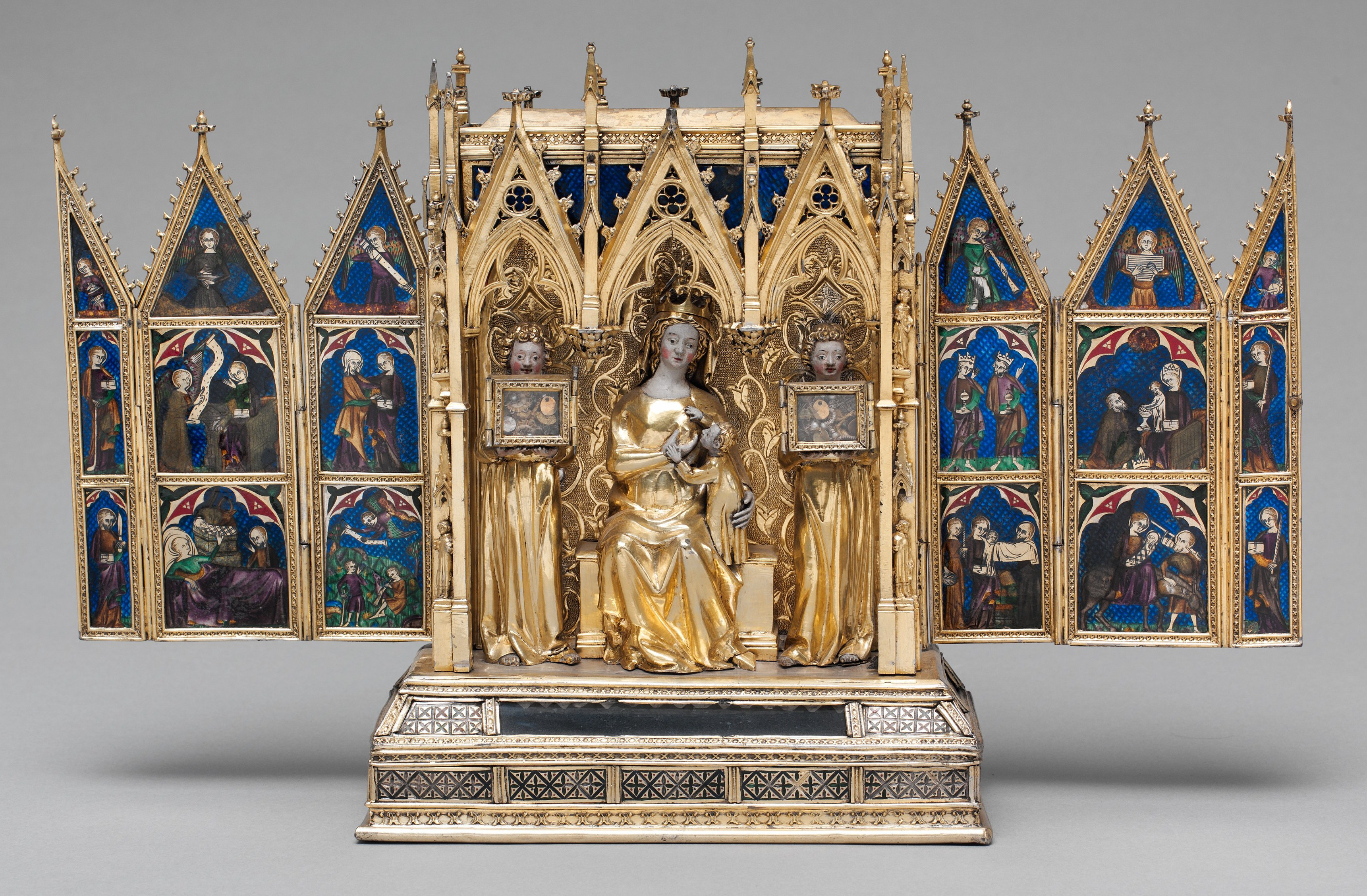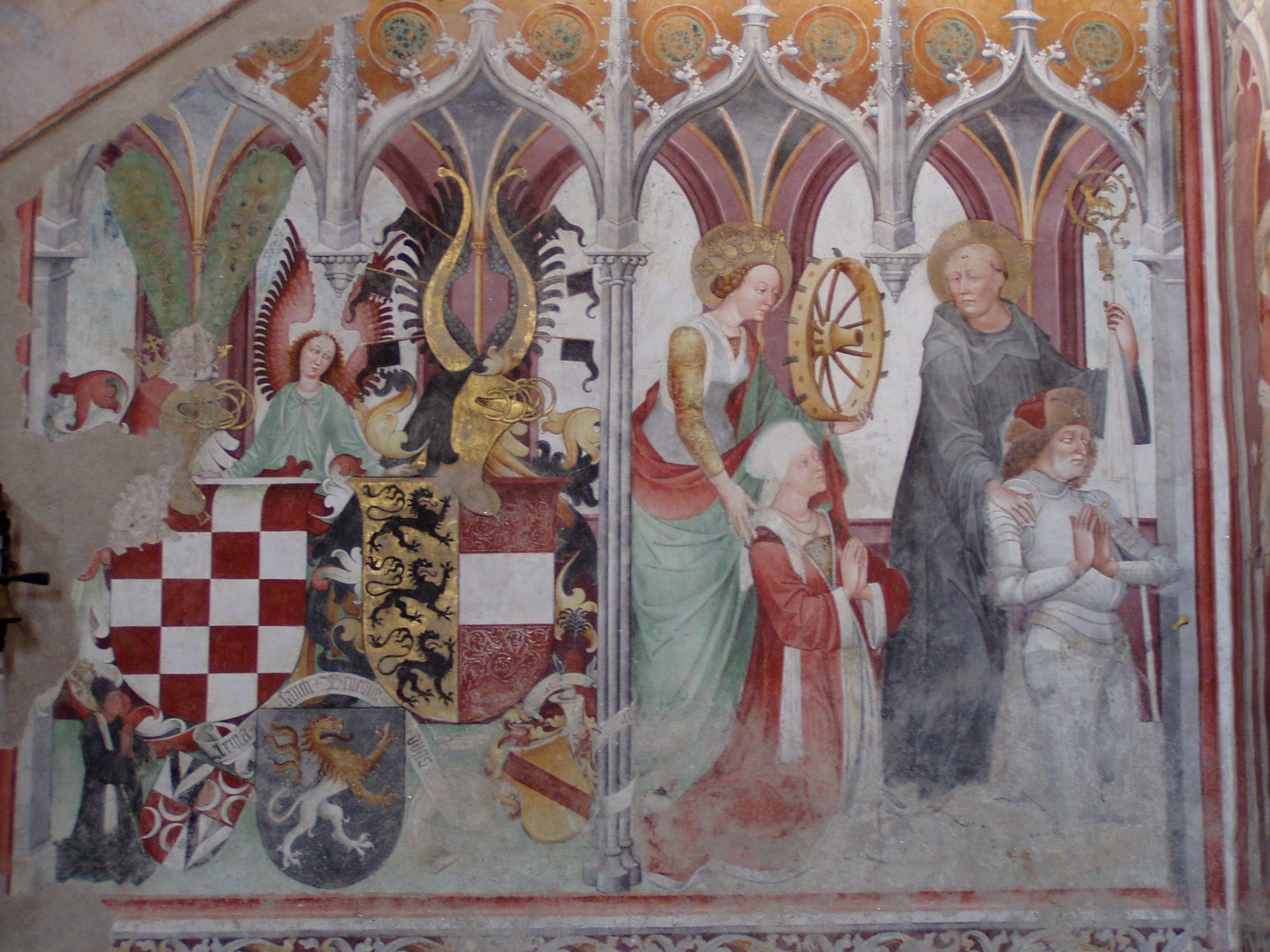|
Cross Of Adelheid
The Cross of Adelheid is an 11th-12th century reliquary in the form of a crux gemmata. It is held in Saint Paul's Abbey, Lavanttal. It was commissioned by Adelheid, daughter of Rudolf of Rheinfelden Rudolf of Rheinfelden ( – 15 October 1080) was Duke of Swabia from 1057 to 1079. Initially a follower of his brother-in-law, the Salian emperor Henry IV, his election as German anti-king in 1077 marked the outbreak of the Great Saxon Revolt a ..., passing to St. Blaise Abbey in the 19th century before coming to its present home. It is made of a wooden core covered with gilded silver plate. On the front are gems, pearls and precious stones. It is 82.9 cm high, 65.4 cm wide and 7.4 to 7.8 cm deep. References External links *http://wwwg.uni-klu.ac.at/kultdoku/kataloge/01/html/25.htm *http://www.aeiou.at/aeiou.photo.index/s/st_paul_im_lavanttal/st_paul_im_lavanttal__adelheid-kreuz_aus_dem_11_jh_im.htm Reliquary crosses Crux gemmata 11th-century sculptures 12th-century scul ... [...More Info...] [...Related Items...] OR: [Wikipedia] [Google] [Baidu] |
Reliquary
A reliquary (also referred to as a '' shrine'', by the French term ''châsse'', and historically including '' phylacteries'') is a container for relics. A portable reliquary may be called a ''fereter'', and a chapel in which it is housed a ''feretory''. Relics may be the purported or actual physical remains of saints, such as bones, pieces of clothing, or some object associated with saints or other religious figures. The authenticity of any given relic is often a matter of debate; it is for that reason, some churches require documentation of the relic's provenance. Relics have long been important to Buddhists, Christians, Hindus and to followers of many other religions. In these cultures, reliquaries are often presented in shrines, churches, or temples to which the faithful make pilgrimages in order to gain blessings. The term is sometimes used loosely of containers for the body parts of non-religious figures; in particular the Kings of France often specified that their he ... [...More Info...] [...Related Items...] OR: [Wikipedia] [Google] [Baidu] |
Crux Gemmata
A ''crux gemmata'' (Latin for jewelled cross) is a form of cross typical of Early Christian and Early Medieval art, where the cross, or at least its front side, is principally decorated with jewels. In an actual cross, rather than a painted image of one, the reverse side often has engraved images of the Crucifixion of Jesus or other subjects. Examples in metalwork are the Cross of Justin II (6th century, in the Vatican Museums), the 'crumpled cross' in the Staffordshire Hoard (8th century), the Cross of Lothair (10th century, Aachen Cathedral Treasury), the Iberian Cross of the Angels and Victory Cross, and the Cross of Cong (1120s?, National Museum of Ireland). History of use In the Late Antique and Early Medieval periods, many objects of great significance, such as reliquaries, were studded with jewels in a style that in recent centuries has been restricted to crowns and other coronation regalia and small pieces of jewellery. In the case of the cross, such decorativ ... [...More Info...] [...Related Items...] OR: [Wikipedia] [Google] [Baidu] |
Saint Paul's Abbey, Lavanttal
Saint Paul's Abbey in Lavanttal (german: Stift St. Paul im Lavanttal) is a Benedictine monastery established in 1091 near the present-day market town of Sankt Paul im Lavanttal in the Austrian state of Carinthia. The premises centered on the Romanesque monastery church were largely rebuilt in a Baroque style in the 17th century. The abbey was dissolved in 1782 by decree of Emperor Joseph II, but resettled in 1809 with monks descending from St. Blaise Abbey in the Black Forest. History The abbey was founded by the Sponheim count Engelbert I, Margrave of Istria since 1090, on the site of a former castle and a church consecrated by Archbishop Hartwig of Salzburg in 991. A follower of Pope Gregory VII and Archbishop Gebhard of Salzburg in the Investiture Controversy with Emperor Henry IV, Engelbert had forfeited his county in the Tyrolean Puster Valley but could retire to the Carinthian estates his father Siegfried I of Spanheim had acquired through his marriage with th ... [...More Info...] [...Related Items...] OR: [Wikipedia] [Google] [Baidu] |
Adelaide Of Rheinfelden
Adelaide of Rheinfelden (or Adelaide of Swabia) (german: Adelheid) (1060s – May 1090), was Queen Consort of Hungary by marriage to King Ladislaus I of Hungary. Life Adelaide was born circa 1065 to Rudolf of Rheinfelden, duke of Swabia and German anti-king, and his second wife, Adelaide of Savoy. Her maternal aunt was Bertha of Savoy, who was married to Henry IV of Germany. Around 1077/8 Adelaide married Ladislaus I of Hungary, a member of the Árpád dynasty. Ladislaus agreed to support Rudolf in his struggle for the throne against Henry IV of Germany. In 1079 Adelaide's mother died, followed in 1080 by her father, who fell at the Battle of Elster. In 1081 Pope Gregory VII wrote to Adelaide, urging her to encourage her husband to support monasteries and be generous to the poor and the weak. Adelaide died in May 1090; her husband outlived her by 5 years. She was buried in Veszprém, where her gravestone remains. Issue Adelaide had two children: * Piroska of Hungary Ire ... [...More Info...] [...Related Items...] OR: [Wikipedia] [Google] [Baidu] |
Rudolf Of Rheinfelden
Rudolf of Rheinfelden ( – 15 October 1080) was Duke of Swabia from 1057 to 1079. Initially a follower of his brother-in-law, the Salian emperor Henry IV, his election as German anti-king in 1077 marked the outbreak of the Great Saxon Revolt and the first phase of open conflict in the Investiture Controversy between Emperor and Papacy. After a series of armed conflicts, Rudolf succumbed to his injuries after his forces defeated Henry's in the Battle on the Elster. Life Rudolf was the son of the Swabian count (''Graf'') Kuno of Rheinfelden. He was first mentioned in a 1048 deed issued by the Salian emperor Henry III as a count in the Swabian Sisgau on the High Rhine (in present-day Northwestern Switzerland), an estate then held by the Prince-Bishopric of Basel. Rudolf's family had large possessions up to Sankt Blasien Abbey in the Black Forest and down to the Aargau beyond the border with the Kingdom of Burgundy. He probably was related to King Rudolph II of Burgundy (d. ... [...More Info...] [...Related Items...] OR: [Wikipedia] [Google] [Baidu] |
Reliquary Crosses
A reliquary (also referred to as a ''shrine'', by the French term ''châsse'', and historically including ''phylacteries'') is a container for relics. A portable reliquary may be called a ''fereter'', and a chapel in which it is housed a ''feretory''. Relics may be the purported or actual physical remains of saints, such as bones, pieces of clothing, or some object associated with saints or other religious figures. The authenticity of any given relic is often a matter of debate; it is for that reason, some churches require documentation of the relic's provenance. Relics have long been important to Buddhists, Christians, Hindus and to followers of many other religions. In these cultures, reliquaries are often presented in shrines, churches, or temples to which the faithful make pilgrimages in order to gain blessings. The term is sometimes used loosely of containers for the body parts of non-religious figures; in particular the Kings of France often specified that their hearts ... [...More Info...] [...Related Items...] OR: [Wikipedia] [Google] [Baidu] |
Crux Gemmata
A ''crux gemmata'' (Latin for jewelled cross) is a form of cross typical of Early Christian and Early Medieval art, where the cross, or at least its front side, is principally decorated with jewels. In an actual cross, rather than a painted image of one, the reverse side often has engraved images of the Crucifixion of Jesus or other subjects. Examples in metalwork are the Cross of Justin II (6th century, in the Vatican Museums), the 'crumpled cross' in the Staffordshire Hoard (8th century), the Cross of Lothair (10th century, Aachen Cathedral Treasury), the Iberian Cross of the Angels and Victory Cross, and the Cross of Cong (1120s?, National Museum of Ireland). History of use In the Late Antique and Early Medieval periods, many objects of great significance, such as reliquaries, were studded with jewels in a style that in recent centuries has been restricted to crowns and other coronation regalia and small pieces of jewellery. In the case of the cross, such decorativ ... [...More Info...] [...Related Items...] OR: [Wikipedia] [Google] [Baidu] |
11th-century Sculptures
The 11th century is the period from 1001 ( MI) through 1100 ( MC) in accordance with the Julian calendar, and the 1st century of the 2nd millennium. In the history of Europe, this period is considered the early part of the High Middle Ages. There was, after a brief ascendancy, a sudden decline of Byzantine power and a rise of Norman domination over much of Europe, along with the prominent role in Europe of notably influential popes. Christendom experienced a formal schism in this century which had been developing over previous centuries between the Latin West and Byzantine East, causing a split in its two largest denominations to this day: Roman Catholicism and Eastern Orthodoxy. In Song dynasty China and the classical Islamic world, this century marked the high point for both classical Chinese civilization, science and technology, and classical Islamic science, philosophy, technology and literature. Rival political factions at the Song dynasty court created strife amongst ... [...More Info...] [...Related Items...] OR: [Wikipedia] [Google] [Baidu] |
12th-century Sculptures
1 (one, unit, unity) is a number representing a single or the only entity. 1 is also a numerical digit and represents a single unit of counting or measurement. For example, a line segment of ''unit length'' is a line segment of length 1. In conventions of sign where zero is considered neither positive nor negative, 1 is the first and smallest positive integer. It is also sometimes considered the first of the infinite sequence of natural numbers, followed by 2, although by other definitions 1 is the second natural number, following 0. The fundamental mathematical property of 1 is to be a multiplicative identity, meaning that any number multiplied by 1 equals the same number. Most if not all properties of 1 can be deduced from this. In advanced mathematics, a multiplicative identity is often denoted 1, even if it is not a number. 1 is by convention not considered a prime number; this was not universally accepted until the mid-20th century. Additionally, 1 ... [...More Info...] [...Related Items...] OR: [Wikipedia] [Google] [Baidu] |





.jpg)

